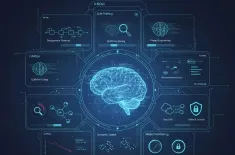Dive into the 7 Stages of AI Development, a comprehensive guide unlocking the stages of building AI for complete understanding and application.
Artificial intelligence (AI) development is a complex and multi-step process that involves planning, data collection, algorithm development, testing, deployment, monitoring, and maintenance. Understanding the 7 stages of AI development is crucial for building effective and reliable AI systems that can improve productivity, efficiency, and innovation in various industries.
Key Takeaways
- Artificial intelligence (AI) development involves 7 key stages: planning, data collection, algorithm development, testing, deployment, monitoring, and maintenance.
- Each stage of AI development is essential for building successful AI systems that meet project goals and deliver desired outcomes.
- The process of AI development requires a diverse range of technical skills, including data analysis, programming, machine learning, and software engineering.
- AI development is a continuous process that involves ongoing monitoring, evaluation, and optimization to ensure long-term effectiveness and impact.
- AI technologies have the potential to revolutionize various industries, including healthcare, finance, transportation, and manufacturing.
What are the Stages of AI Development?
Developing artificial intelligence systems requires a structured approach that follows a set of well-defined stages. The AI development process typically involves the following phases:
- Planning: This stage involves defining the project goals, determining the scope of the AI system, and outlining the desired outcomes. Planning lays the foundation for the entire AI development life cycle and is critical to the project's success. It also involves conducting a feasibility study and creating a comprehensive plan for AI development.
- Data Collection and Preparation: In this stage, the focus is on collecting and preparing data for AI development. It involves identifying data sources, selecting relevant features, and constructing a high-quality and diverse dataset. Additionally, this stage also requires data preprocessing techniques and considerations for ensuring data privacy and security.
- Algorithm Development and Training: In this stage, the developer creates optimized algorithms that power AI systems. The developer can use different approaches to algorithm development, including machine learning and deep learning techniques. The algorithms are then trained using labeled data to provide the AI model with the necessary knowledge and improve its performance via iterative refinement.
- Testing and Evaluation: This stage involves comprehensive testing methodologies, such as unit testing, integration testing, and performance testing, to ensure the accuracy, reliability, and efficiency of AI models.
- Deployment and Integration: This stage involves deploying the AI systems into real-world environments and integrating them into existing software infrastructure. This stage also involves addressing challenges and considerations, including scalability, compatibility, and user acceptance.
- Monitoring and Maintenance: The ongoing monitoring and maintenance of AI systems are crucial to its longevity and effectiveness. The developer monitors system performance, detects and addresses biases and errors, and continuously updates and optimizes AI models.
The different stages of AI development form the AI development roadmap, one that developers must follow to build successful AI systems. The AI development lifecycle ensures that the final product meets the project's goals, objectives, and the needs of users.
Stage 1: Planning and Goal Setting
The first stage of the AI development process involves planning and goal setting. This is a critical stage as it sets the foundation for the entire AI system and determines its success. In this stage, the project team defines the scope of the AI system, outlines the desired outcomes, and creates a comprehensive plan for AI development.
Planning AI development requires a strategic approach that considers the organization's overall goals, the target audience, and the resources and infrastructure available.
During the planning stage, a feasibility study should be conducted to evaluate the viability of the proposed AI system. This involves researching the potential use cases, analyzing data availability and quality, and identifying any technical and financial limitations. Once a determination has been made about the feasibility of the project, the team can move on to creating a more detailed plan.
AI development is a complex process, and planning is essential to ensure that the project is executed efficiently and effectively.
The plan should include a breakdown of the project into smaller tasks and timelines for completing each task. It should also identify the roles and responsibilities of the project team members, as well as the resources required for each stage of the project.
The planning stage is critical for ensuring that the AI development process is structured and organized, enabling the project team to make informed decisions and manage resources effectively.
Stage 2: Data Collection and Preparation
In the AI development process, the second stage is data collection and preparation. This stage involves gathering the necessary data that will be used to develop the AI system.
Collecting the right data is essential for the success of an AI model. The data should be diverse, high-quality, and relevant to the problem the AI system is intended to solve. It is common to collect large amounts of data, which can be time-consuming and expensive.
Before collecting data, it is important to define the use cases for the AI system and the questions it is intended to answer. In this way, you can determine the type of data required to train the AI model effectively.
After collecting the data, it must be prepared and processed to ensure it is suitable for use in the AI system. This usually involves cleaning the data, removing outliers and errors, and transforming it into a format that is compatible with the AI model.
“Garbage in, garbage out” is a common saying in the world of AI. This emphasizes the importance of collecting and preparing high-quality data for an AI system
Data privacy and security must also be considered during this stage. It is important to ensure that the data is anonymized and that any sensitive information is protected. Additionally, it is crucial to comply with relevant regulations to avoid any legal or ethical issues that may arise.
| Data Collection and Preparation | Considerations |
|---|---|
| Collecting Data |
|
| Preparing Data |
|
| Data Privacy and Security |
|
This stage is crucial in the AI development process and lays the foundation for the subsequent stages. Collecting and preparing high-quality data ensures that the AI system will be accurate and reliable, and that it will provide the desired outcomes.
Stage 3: Algorithm Development and Training
Algorithm development is a critical stage in the AI development process, as it determines the functionality and performance of an AI system. The key objective of this stage is to design algorithms that can facilitate the learning and decision-making capabilities of an AI model.
Algorithm development for AI involves creating a set of rules and instructions that enable machines to learn from data inputs and make predictions based on that knowledge. This can be accomplished through a range of techniques, including supervised, unsupervised, and reinforcement learning.
The process of AI training involves using labeled data to fine-tune the algorithm's performance and enhance its accuracy. The training process is iterative, meaning the algorithm goes through multiple rounds of training to refine its decision-making abilities.
Supervised Learning
This approach involves providing labeled data inputs to an algorithm to help it learn how to make accurate predictions. The algorithm is trained on a large dataset, where each data point is labeled with the correct output. The algorithm then uses this information to learn how to accurately predict the output for new data points.
Unsupervised Learning
This technique involves training an algorithm on a dataset without providing labeled data inputs. The algorithm learns to identify patterns, similarities, and differences within the dataset, enabling it to identify outliers and make predictions based on its observations.
Reinforcement Learning
This approach involves training an algorithm through trial and error. The algorithm is trained to make decisions based on a reward or penalty system. The algorithm receives feedback based on its decisions, enabling it to learn from its successes and failures.
In conclusion, algorithm development and AI training are critical stages in the AI development process. By designing effective algorithms and fine-tuning their performance through training, developers can create AI systems that can make accurate predictions, facilitate decision-making, and provide valuable insights to businesses and organizations.
Stage 4: Testing and Evaluation
After the AI model is developed and trained, it is essential to test and evaluate its performance to ensure its accuracy, reliability, and efficiency. Testing and evaluation are crucial stages in the AI development process that help identify any potential errors or biases that could affect the model's performance.
The testing stage involves a comprehensive evaluation of the AI system, analyzing its output against expected results. Unit testing is performed to test individual components of the model, while integration testing is done to check the model's compatibility with other software systems. Performance testing is conducted to evaluate the model's speed, capacity, and resource requirements.
It is important to test AI models with diverse datasets to ensure they perform accurately in various scenarios and are not biased towards a particular data subset.
Evaluation metrics are used to measure the model's performance and accuracy against the expected results. These metrics include precision, recall, F1 score, and accuracy. They help determine the model's effectiveness in making accurate predictions, minimizing errors, and detecting anomalies.
| Evaluation Metric | Description |
|---|---|
| Precision | The proportion of true positive results among the predicted positive outcomes. |
| Recall | The proportion of true positive results among the actual positive outcomes. |
| F1 Score | A weighted average of precision and recall, representing the model's accuracy. |
| Accuracy | The proportion of correct predictions made by the model over all predictions. |
By evaluating the model's performance using these metrics, AI developers can identify and address any weaknesses or issues in the model, resulting in an improved and more effective AI system.
Stage 5: Deployment and Integration
After completing the testing and evaluation stages, the AI system is ready for deployment and integration into real-world settings. This stage involves installing the AI system on appropriate hardware and software infrastructure and making it operational for the end-users.
During this stage, the system developer needs to ensure that the AI system works well in various environments and under different conditions. They must also ensure that the system's performance remains consistent and meets the users' requirements and expectations.
The deployment process involves several steps such as:
- Setting up the necessary hardware and software infrastructure for the AI system to operate efficiently.
- Installing the AI system on the infrastructure and integrating it with existing software systems.
- Configuring the AI system to meet specific requirements and user needs.
- Training the end-users on how to use the AI system and resolving any issues that may arise during the initial implementation.
It is essential to consider the scalability and compatibility of the AI system during deployment. The system must be able to scale up or down based on changing user needs and market demands. Additionally, the AI system should be compatible with various operating systems, hardware platforms, and other applications.
To ensure proper deployment and integration, it's important to work closely with the system's end-users, gathering feedback and addressing any issues as they arise.
Stage 6: Monitoring and Maintenance
Once an AI system has been deployed and integrated, the work is far from over. Ongoing monitoring and maintenance are essential to ensure that the system remains accurate, reliable, and effective over time.
AI Monitoring: Monitoring AI systems involves tracking their performance, detecting errors and biases, and identifying opportunities for improvement. This requires collecting and analyzing data on system outputs and user feedback. Monitoring can be automated using specialized tools or performed manually by trained personnel.
AI Maintenance: Maintenance involves updating and optimizing AI models to improve their performance and ensure their longevity. This may include debugging code, retraining models with new data, and refining algorithms to reduce bias and increase accuracy. Maintenance may also involve making changes to the system architecture or hardware to accommodate evolving business needs.
Effective monitoring and maintenance are critical to the success of AI systems in the long-term. In some cases, the consequences of failing to monitor or maintain a system can be severe, such as when an autonomous vehicle malfunctions and causes an accident. Therefore, companies and organizations that develop AI systems must prioritize ongoing monitoring and maintenance to ensure the safety and efficacy of their products.
Conclusion
Artificial Intelligence (AI) development is a complex and continuous process that involves seven key stages. Each stage, from planning and goal setting to monitoring and maintenance, plays a crucial role in building successful AI systems.
As industries continue to adopt AI technologies, understanding the stages of AI development is essential for creating effective and efficient systems.
By following a structured AI development process, organizations can ensure they are collecting high-quality data, developing accurate algorithms, and integrating AI systems into existing infrastructure. Additionally, ongoing monitoring and maintenance can help optimize AI models and prevent biases and errors.
Overall, mastering the stages of AI development is critical for unlocking the full potential of artificial intelligence and driving innovation in a range of industries.



































